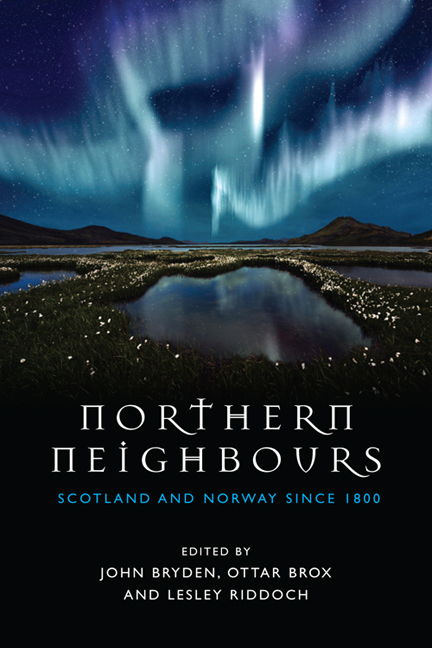Book contents
- Frontmatter
- Contents
- Acknowledgements
- Foreword
- 1 Introduction
- 2 Towards a Theory of Divergent Development
- 3 Cousins Divided? Development in and of Political Institutions in Scotland and Norway since 1814
- 4 Agrarian Change in Scotland and Norway: Agricultural Production, Structures, Politics and Policies since 1800
- 5 The Evolution of Local Government and Governance in Scotland and Norway
- 6 The Development of Industry and North Sea Oil in Scotland and Norway
- 7 Reflections on the Making of Norway
- 8 Money and Banking in Scotland and Norway
- 9 Religion in Scotland and Norway
- 10 The Nordic Welfare Model in Norway and Scotland
- 11 Access, Nature, Culture and the Great Outdoors – Norway and Scotland
- 12 Education in Norway and Scotland: Developing and Re-forming the Systems
- 13 Norway and the United Kingdom/Scotland after the Second World War
- 14 Conclusions
- The Contributors
- Bibliography
- Index
2 - Towards a Theory of Divergent Development
Published online by Cambridge University Press: 05 August 2016
- Frontmatter
- Contents
- Acknowledgements
- Foreword
- 1 Introduction
- 2 Towards a Theory of Divergent Development
- 3 Cousins Divided? Development in and of Political Institutions in Scotland and Norway since 1814
- 4 Agrarian Change in Scotland and Norway: Agricultural Production, Structures, Politics and Policies since 1800
- 5 The Evolution of Local Government and Governance in Scotland and Norway
- 6 The Development of Industry and North Sea Oil in Scotland and Norway
- 7 Reflections on the Making of Norway
- 8 Money and Banking in Scotland and Norway
- 9 Religion in Scotland and Norway
- 10 The Nordic Welfare Model in Norway and Scotland
- 11 Access, Nature, Culture and the Great Outdoors – Norway and Scotland
- 12 Education in Norway and Scotland: Developing and Re-forming the Systems
- 13 Norway and the United Kingdom/Scotland after the Second World War
- 14 Conclusions
- The Contributors
- Bibliography
- Index
Summary
INTRODUCTION
The question I address in this chapter is how our findings on the long-term development of Norway and Scotland relate to some key themes in the Theory of Development. I approach this question in the first instance from a Classical economic standpoint. That is to say, I examine the key resources and the means by which these are transformed into improved economic welfare for people. In using a comparative approach, I look for explanations of the different development paths ‘chosen’ in Norway and Scotland first in ways in which land and natural resources are owned and managed through time, next in issues of human labour, ingenuity and reward for effort, then in capital and accumulation, and last but not least institutions. Within the rubric of institutions, I believe that our findings show that the State and State policies have played a key role in the processes of allocation, distribution and transformation of both resources and of rewards. Secondly, we find the notion of ‘path dependency’, as used by Bratburg and Brandal in Chapter 4, very helpful in thinking about the linkages between politics, resources, institutions and outcomes over relatively long periods of time.
LAND AND NATURAL RESOURCES
The first proposition is that the distribution of land was a founding factor in the emerging political, social and economic development of Scotland and Norway after the seventeenth century. While the roots of the market and fundamental differences in land ownership and rights between Scotland and Norway go far back into the mists of history, for practical purposes it is the period after the Reformation that is particularly important because, as Chapter 1 argues, the destiny of the land owned by the pre-Reformation Church was quite different in the two countries, and set a pattern for the following 400 years.
Adam Smith wrote that ‘a man born to great fortune … is very seldom capable’ of improving land with profit. The great landowners were more interested in land as a source of power and high office, in luxury expenditure to aggrandise (part of) their estates, and in dependent bondmen who both worked the land and formed the lord's military capacity.
- Type
- Chapter
- Information
- Northern NeighboursScotland and Norway since 1800, pp. 27 - 41Publisher: Edinburgh University PressPrint publication year: 2015



